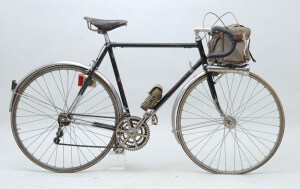 Randonneuring has finally come to Thailand. And while some of you long distance cycling junkies are delighted to hear this news many others are probably wondering, “What is Randonneuring?”
Randonneuring has finally come to Thailand. And while some of you long distance cycling junkies are delighted to hear this news many others are probably wondering, “What is Randonneuring?”
Randonneuring is long-distance, unsupported cycling within designated time limits. Randonneuring events, called Brevets or Randonnées are noncompetitive and resemble a mix between multi-day bicycle touring and a rolling party of several like-minded cycling friends. Randonneuring began in Italy and flourished in France at the end of the 19th century. Professional road racing and cycle touring trace their early roots to randonneuring. The original Grand Randonnée, now known as Paris-Brest-Paris, was first held in 1891 and inspired the Tour de France.
Brevets or Randonnées are organized in the following distances and time limits:
- 200km (13.5 hours time limit to complete entire distance) – A rider must successfully complete a 200km brevet to earn the title of “Randonneur”
- 300km (20 hours)
- 400km (27 hours)
- 600km (40 hours)
- 1,000km (75 hours)
- 1,200km (90 hours) – These are usually annual events known as “Grand Randonnées”
What equipment do I need?
Cyclists considering a brevet should not be deterred from participating by thinking that they need specialized equipment or a “randonneuring bicycle.” For a 200-kilometer brevet, most riders travel fairly light. Supplies necessary to fix basic problems (a flat repair kit and good multi-tool), a variety of clothing items if the temperature changes or rain is expected, and a couple of water bottles is really all that you will need. For rides longer than 200 kilometers, lights and appropriate reflective clothing are highly recommended (and often required by organizers). Many randonneurs choose to ride classic bicycles with steel frames, relaxed geometry, and ample clearance for racks, fenders, and wide tires.
How does the time limit work?

Once a brevet begins, the clock runs continuously. There are no changes made to any individual riders time due to bad weather, accidents, navigational errors, or mechanical breakdowns. Each rider must do all cycling, sleeping, eating, bicycle repairs, and taking care of any unforeseen mishaps within the time limit. All finishers of brevets are listed alphabetically, without reference to or recognition of finishing time.
Although brevet time limits are quite generous, many randonneurs seek to improve their rolling speed in order to enable them more time to rest, and to deal with unexpected mishaps along the road. Randonneuring favors efficiency and preparedness over speed. Planning rest stops, maximizing comfort on the bike, and maintaining a consistent pace are just as critical to success as fitness.
Control Stations (“Checkpoints”), at an approximate distance of 50 kilometers apart are set in place along the route in order to keep riders on the designated course. The control stations serve as a time check, where each rider has his or her brevet card stamped to prove passage through the station within the allotted time. Each control station has an “opening” and “closing” time and riders must pass through the control station between those designated times.
Food and sleep
The 600-kilometer and longer brevets present randonneurs with the issue of how to manage food and sleep. This is one of the greatest aspects of randonneuring because each rider is allowed to decide for themselves how best to attend these issues. Some randonneurs bring a sleeping pad and catch quick catnaps along the route; others check in at hotels and enjoy a full night’s rest before setting off the next day. Individual randonneurs address meals and snacks with an equal amount of diverse approaches; some carry all their own food and replenish at convenience stores, while others search out restaurants and cafes. Riders who have special dietary needs that may not be readily available in the countryside of Thailand, should carry those items with them.
How do I get started?
In order to become a randonneur you must first complete a 200-kilometer brevet. Once you are a randonneur you may register and participate in longer distance brevets. In order to be eligible to participate in a 1,200-kilometer event you must first qualify by successfully completing a full brevet series (200km, 300km, 400km, and 600km) in the same calendar year of the Grand Randonnées you wish to join. This qualification process ensures that randonneurs are sufficiently prepared for the challenge ahead and that they have the best opportunity to fully enjoy the momentous experience.
Step 1 – Join and ‘Like’ the Audax Randonneur Thailand FaceBook group
Audax Randonneur Thailand is an organization whose primary goals are to promote randonneuring in Thailand and to serve Thailand’s randonneuring community.
(***UPDATE – As of April 2014, you can now get your Audax Randonneur Thailand membership ID by completing the form on their new website at www.AudaxThailand.com The website also has information regarding upcoming rides, participant lists, results, route information, and photos***)
Step 2 – Successfully complete your first 200-kilometer brevet and achieve the title of randonneur.
Step 3 – Watch the BicycleThailand.com events calendar and participate in future brevets of the Audax Randonneur Thailand group, the Bangkok Randonneurs, and the Central Long Distance Biking club. They have released a tentative schedule listing some of the upcoming 2014 randonneur brevets in Thailand.


Leave a Reply